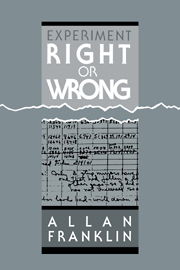Book contents
- Frontmatter
- Contents
- Preface
- Acknowledgments
- Introduction
- I EXPERIMENT AND THE DEVELOPMENT OF THE THEORY OF WEAK INTERACTIONS: FROM FERMI TO V-A
- 1 Fermi's theory
- 2 Toward a universal Fermi interaction; muons and pions
- 3 Beta-decay theory following World War II
- 4 The discovery of parity nonconservation
- 5 The V-A theory of weak interactions and its acceptance
- II TOWARD A PHILOSOPHY OF EXPERIMENT
- Conclusion
- Appendix
- References
- Index
5 - The V-A theory of weak interactions and its acceptance
Published online by Cambridge University Press: 15 September 2009
- Frontmatter
- Contents
- Preface
- Acknowledgments
- Introduction
- I EXPERIMENT AND THE DEVELOPMENT OF THE THEORY OF WEAK INTERACTIONS: FROM FERMI TO V-A
- 1 Fermi's theory
- 2 Toward a universal Fermi interaction; muons and pions
- 3 Beta-decay theory following World War II
- 4 The discovery of parity nonconservation
- 5 The V-A theory of weak interactions and its acceptance
- II TOWARD A PHILOSOPHY OF EXPERIMENT
- Conclusion
- Appendix
- References
- Index
Summary
THE SUGGESTION OF V-A THEORY
The situation discussed at the end of the last chapter was described in papers that proposed that a Universal Fermi Interaction, one that applied to all weak interactions, was a linear combination of V and A. The theory was offered by Sudarshan and Marshak (1957, 1958) and by Feynman and Gell-Mann (1958). This was exactly the opposite conclusion drawn four years earlier by Konopinski and Langer, who had stated, “As we shall interpret the evidence here, the correct law must be what is known as an STP combination” (1953, p. 261).
Sudarshan and Marshak examined the available evidence from nuclear β decay and other weak interactions, including strange particle decays, and concluded that the only possible choice for a Universal Fermi Interaction was a linear combination of V and A, even though there was evidence apparently in conflict with this choice. The four experiments cited in opposition to the V-A theory were
The electron–neutrino angular correlation experiment on He6 by Rustad and Ruby (1953, 1955), which gave T as the β-decay interaction.
The sign of the electron polarization from muon decay.
The frequency of the electron mode in pion decay.
The asymmetry in polarized neutron decay, which was smaller than predicted.
They suggested,
All of these experiments should be redone, particularly since some of them contradict the results of other recent experiments on the weak interactions.
- Type
- Chapter
- Information
- Experiment, Right or Wrong , pp. 75 - 96Publisher: Cambridge University PressPrint publication year: 1990



